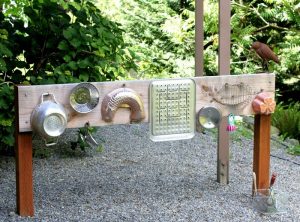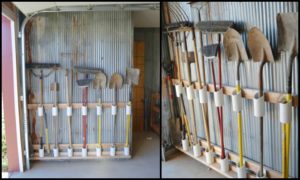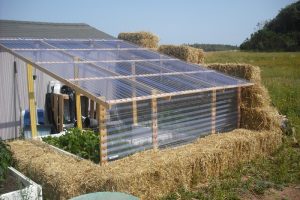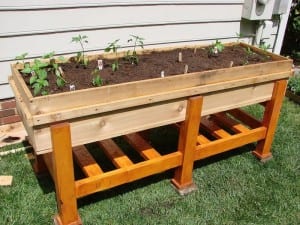Last Updated on January 29, 2025 by teamobn
An outdoor hanging daybed is a versatile piece of furniture that can be used in a variety of ways. It can be used as a place to relax, or it can be used as a place to sleep. It can also be used as a place to lounge, a place to read a book or a place to work. There are many different ways to use an outdoor hanging daybed, and it can be a great addition to any home.
The average daybed can hold between 250 and 300 pounds. However, some daybeds are designed to hold more weight, and some are designed to hold less. It is important to check the weight limit of your daybed before purchasing it, to ensure that it will be able to accommodate your needs.

Contents [show]
Making a DIY Hanging Daybed
Materials:
- 6 – 1 x 6 x 8 Pine Boards
- 8 – 1 x 4 x 8 Pine Boards
- 2 – 1/4″ x 3″ Carriage Bolts
- 2 – 1/4″ x 2″ Carriage Bolts
- 4 – 1/4″ Washers
- 4 – 1/4″ Nylon Nuts
- 2 – 3/8″ Eyebolts
- 2 – 3/8″ Nylon Nuts
- 4 – 3/8″ Fender Washers
- 2 – Large S Hooks
- 2 – Small S Hooks
- Paint
- 30′ Chain – rated at 340 lbs
Tools:
- Measuring Tape
- Miter Saw
- Band Saw
- Jigsaw
- Cordless Drill
- Sander
- Paintbrush
- Router
- Wood Clamps
Steps
1. Gather the Materials Needed
Before beginning any project, it is crucial to ensure that you have all of the necessary materials on hand, as well as the right tools for the job. This will save you time and frustration later on. For this particular project, you will need to gather all the materials and tools listed above.
When choosing the materials for your daybed, it is important to consider the weight capacity. Make sure to pick materials that are strong enough to support both the daybed and its users. This is a necessary step to ensure that your daybed is safe and stable.
2. Build the Footer
When it comes to designing your hanging daybed, you have a few options for the footer. You can go with a plain rectangle, or you can get creative and sketch up a design of your own! If you’re not sure what you want, take a look at some examples online or in magazines to get some inspiration.
Once you have an idea of what you want, get to work planning out your design. Keep in mind the size and shape of your footer, as well as the overall look you’re going for.
3. The Bottom Supports
When building a hanging daybed, one of the key elements is ensuring that it is properly supported. This means having enough bottom supports to evenly distribute the weight of the daybed and prevent it from sagging or collapsing.
Depending on the size of your daybed, you should have at least five (5) bottom supports attached to the footer. If you have a larger daybed, you need to add additional support.
4. Attaching the supports to the footer
Lined up the side supports flush with the top of the footer and screw them down. Then you should clamp a board into place so that you can mount the other three supports against it and screw them down to the footer.
5. The Deck
Cut 5 pcs of 1 x 6 to length and then put in pocket holes on each end. Then, attach the first board, start on the side supports first then on the other three bottom supports. Make sure that the pocket holes are facing inwards so that they are not visible.
Once all the boards are in place, use a drill to attach the screws. After the first board was complete, repeat the steps to attach the other 4 boards.
6. The Back Supports
Later, two of the back sides will be getting a carriage bolt and a chain through them, so to beat them up, you should cut seven supports and glue together two boards twice. If necessary, use a clamp to hold the glued supports together and let them dry up. That will give you three normal supports and 2 thicker ones.
7. The Back Assembly
Cut two rails (the top and the bottom) and a bunch of stiles (which you can do by setting up a stop block on your mitre saw). Then, lay them out to get a visual of your back assembly. This will help you determine the placement of the stiles and how they will fit then screw them together.
8. Finishing / Painting
If you choose to paint your outdoor hanging daybed, you can sand them first and paint it with the colour of your choice. But if you want to leave it be, make sure to have a clear finish. This will help protect the wood from weathering and also give it a nice shine.
9. Assembling the Parts Together
This step is a little critical though, you need to first figure out the angle that would look nice and use a drill press to drill a quarter-inch hole. Then you can start clamping it into place so you will have a guide when you drill a hole into the bottom support. Next, put in the carriage bolt, flash washer and nylon net.
You can use an angle finder to repeat the steps on the other side, and now, you’ll have the beginning of the back which you can attach the back assembly. Next, attach the rest of the back support, and make sure to space out the slots so that you can’t see them in front of the swing.
10. The Arm Design
Now that you have assembled the necessary parts, you can proceed to design your arms support. Keep in mind the weight and size of the object you will be supporting, as well as the range of motion you will need. With these factors in mind, sketch out a few potential designs. Once you have a few potential designs, select the one you think will work best and work it out.
When everything else is fastened and done, it was just a matter of hanging it out
11. Attaching the hardware
For the front of the hanging daybed, you can use heavy-duty eyebolts with a fender washer and a nylon nut on each side. And on the back, you can simply move out the carriage bolt and attach the chain. Then grab a paddle bit with the same diameter as the chain and drill the part of the arm, where the chain should go through.
You can then combine the back chain and the front chain by attaching them together with S hooks. This will create a more secure connection and help to prevent the chains from becoming tangled. You will have to do the same on the other side of the hanging daybed.
12. Attaching it to a Platform
Now that your outdoor hanging daybed is complete, you can finally look for a sturdy platform or tree to hang it from and start enjoying your DIY hanging daybed. Keep in mind, however, that you’ll need to ensure that the platform or tree you choose can support the weight of the daybed and anyone who can use it.
Click on any image to start the lightbox display. Use your Esc key to close the lightbox.![]()
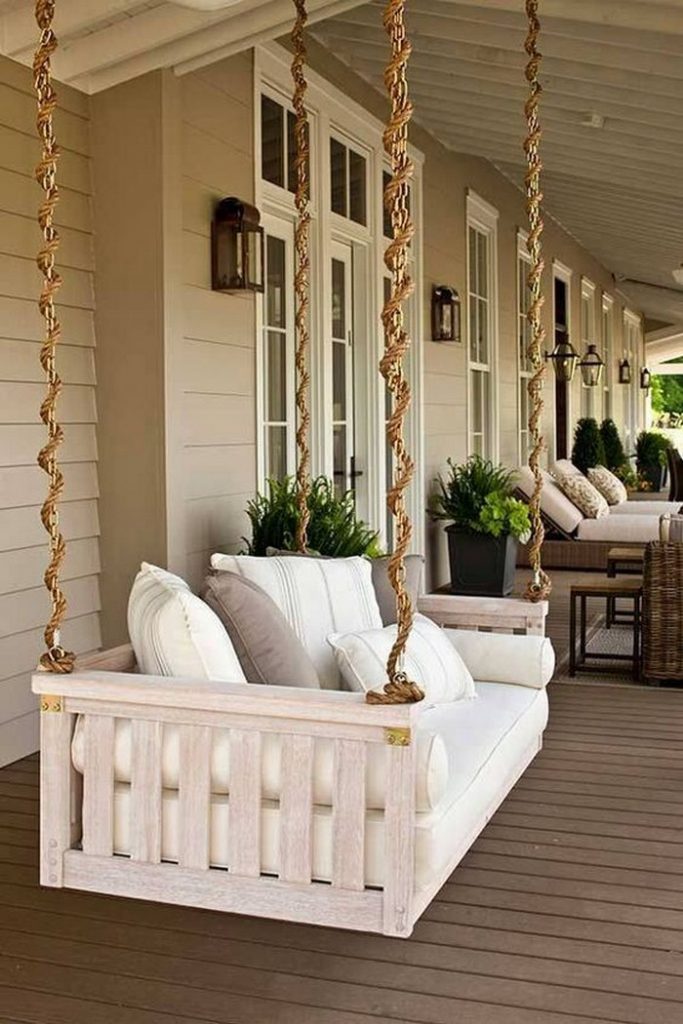
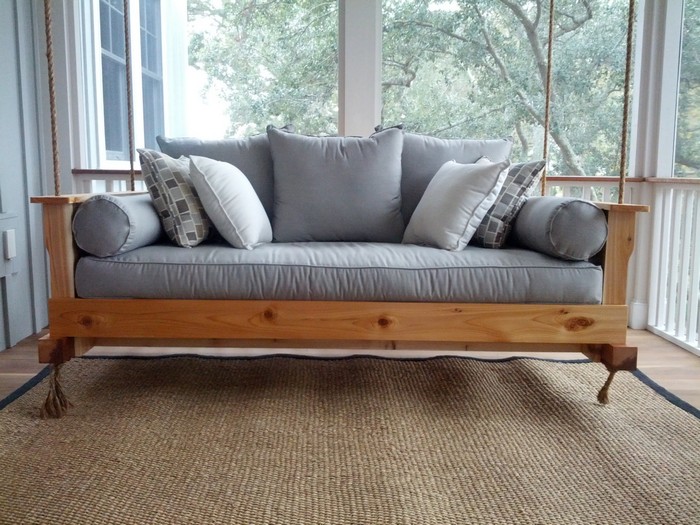

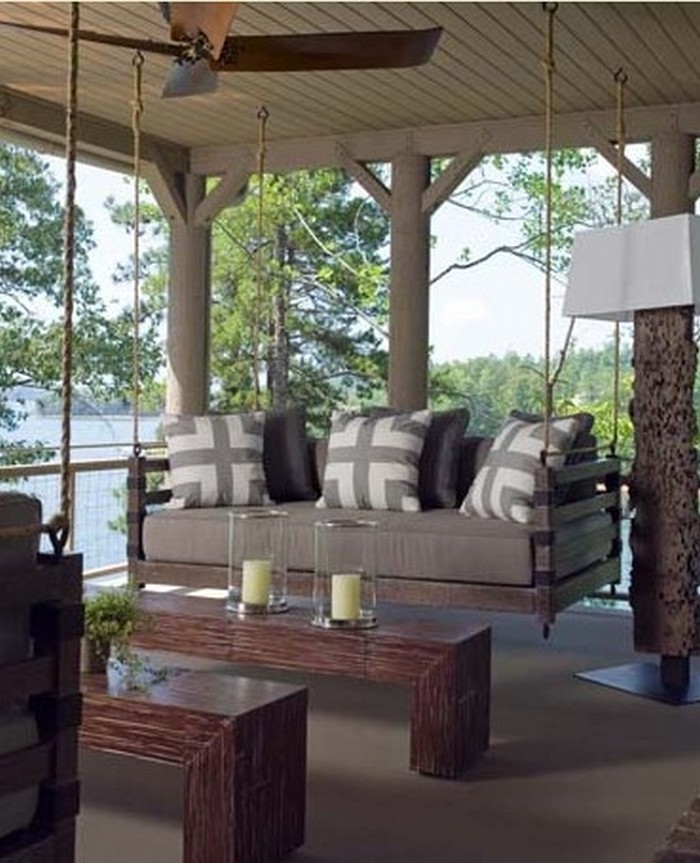


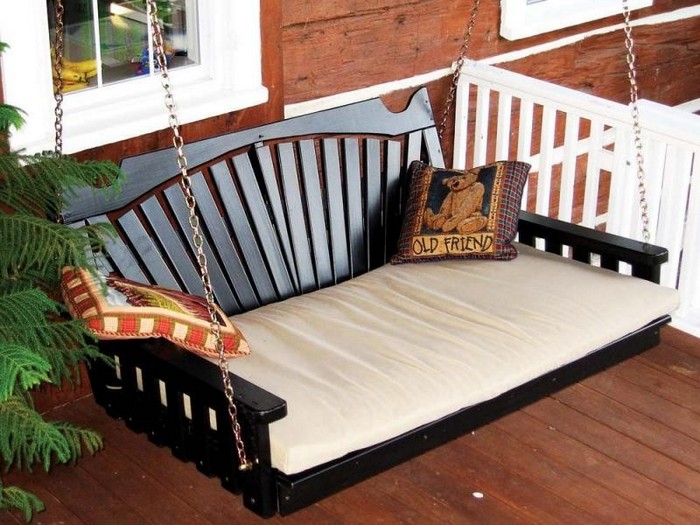
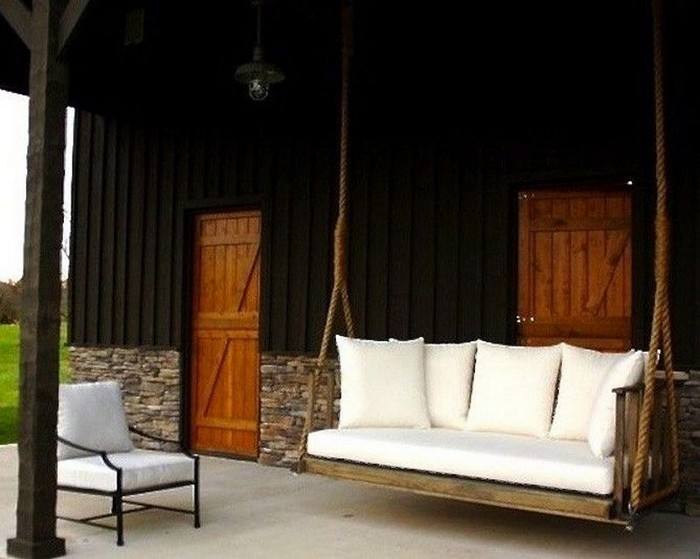
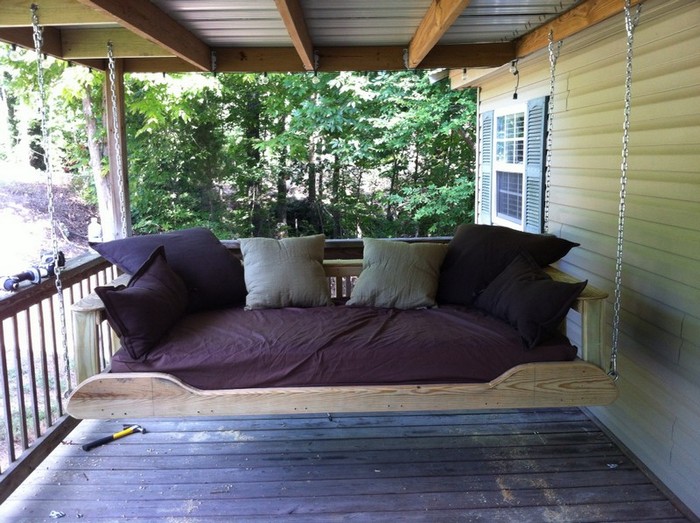
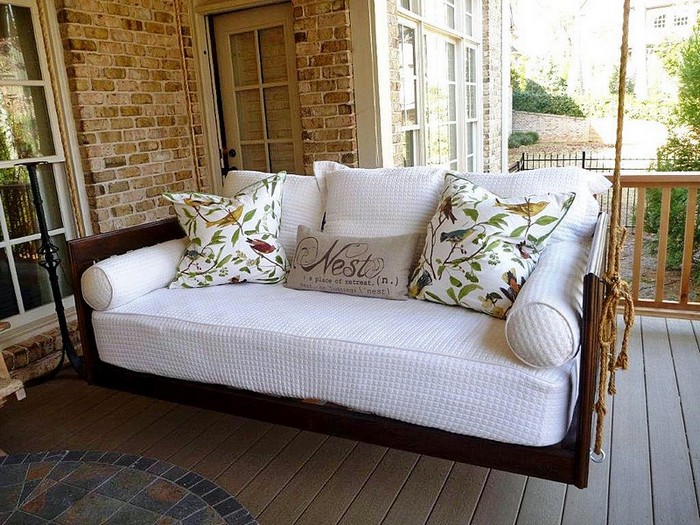
You can get a visual guide from April Wilkerson here:
DIY Hanging Daybed Plans
Building a hanging daybed isn’t exactly a quick weekend project! But anybody who’s simply willing to squeeze in a couple of hours every day can make their own hanging daybed swing in a week! This DIY project doesn’t require any special tools or skills.
However, if you are thinking of taking on this project we recommend you consult a professional builder or carpenter (unless you already are one 
As long as you’ve sought advice from a professional and have taken your time in building a strong and sturdy daybed frame, you’ll be able to enjoy many relaxing and super-comfortable hours in your DIY hanging daybed swing. With a little bit of care and upkeep, your daybed swing will provide you with years of enjoyment.
Just imagine getting your much-needed afternoon nap or reading a great book on your hanging daybed! It sure is worth the time and all the work needed, isn’t it? 
Be inspired by taking a look at our album of hanging daybed swings below, and learn how to build one by heading over to the step-by-step tutorial by Jordan Valley Home and Garden Club.
Choosing the Right Materials for a Durable Hanging Daybed
A hanging daybed is more than just a stylish addition to your home. It needs to be strong enough to support weight, durable against outdoor conditions, and comfortable for relaxation. Choosing the right materials ensures that your hanging daybed will last for years without excessive wear or damage. Below are the best materials to consider for a long-lasting hanging daybed.
Best Types of Wood for a Hanging Daybed
Not all wood is suitable for outdoor furniture. Here are the best options for durability:
- Cedar – Naturally resistant to moisture, rot, and insects. Ideal for humid climates.
- Teak – A premium hardwood that withstands weather changes and requires minimal maintenance.
- Redwood – A strong, weather-resistant option that doesn’t warp easily.
- Pressure-treated Pine – An affordable alternative that resists decay when properly sealed.
If your hanging daybed will be placed outdoors, choose wood with natural oils or apply a protective sealant to prevent water damage.
Choosing the Right Rope, Chains, or Hardware
The suspension system plays a crucial role in safety and longevity. Consider these options:
- Galvanized steel chains – The strongest and most durable choice, resistant to rust and corrosion.
- Marine-grade rope – Offers a softer, rustic look but must be thick enough (at least ¾ inch diameter) to support weight.
- Heavy-duty eye bolts and brackets – Ensure they are stainless steel or powder-coated for weather resistance.
Always check the weight ratings of chains and bolts to ensure your hanging daybed can safely support occupants.
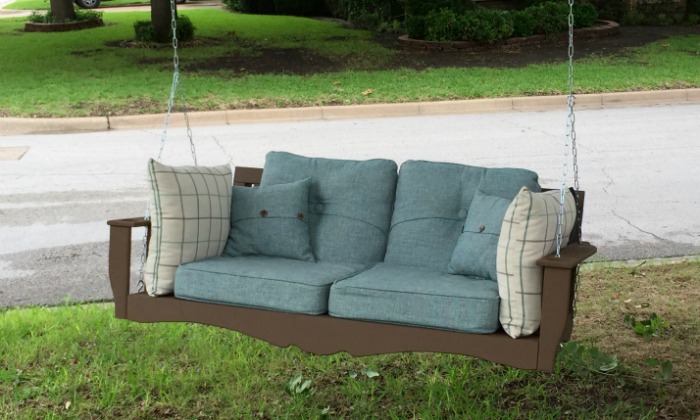
Weather-Resistant Finishes and Protective Coatings
Outdoor hanging daybeds are exposed to sun, rain, and temperature fluctuations. Protect your materials with:
- Exterior-grade paint – Adds color while sealing the wood against moisture.
- UV-protective sealant – Prevents sun damage and fading.
- Waterproof stain – Enhances the wood’s natural look while providing weather resistance.
If your hanging daybed is placed on a covered porch, you do not need heavy-duty protection, but regular maintenance will keep it in top condition.
Cushion and Fabric Considerations
For maximum comfort and durability, choose weatherproof cushions and fabrics:
- Sunbrella fabric – Fade-resistant, mold-proof, and easy to clean.
- Quick-dry foam – Prevents moisture buildup and mildew.
- Removable, washable covers – Makes cleaning and maintenance effortless.
Properly selecting the right materials for your hanging daybed ensures both longevity and comfort. By using durable wood, high-quality suspension hardware, and weather-resistant finishes, you’ll enjoy a sturdy, stylish, and reliable piece of furniture for years to come.
Best Places to Hang a Hanging Daybed
A hanging daybed is a versatile and stylish addition to any home, but choosing the right location is crucial for both safety and comfort. The best placement depends on factors like available space, structural support, and the atmosphere you want to create. Here are the best places to install a hanging daybed and what to consider for each option.
Porch or Covered Patio
A hanging daybed on a porch or covered patio provides a cozy, shaded retreat that stays protected from rain and direct sunlight. This is one of the most common and practical locations since porch ceilings are typically strong enough to support the weight of a daybed and its occupants. Ensure your ceiling joists are properly reinforced, and use heavy-duty eye bolts and chains for secure suspension.
Backyard Pergola
If you have a pergola, it can be an ideal spot for a hanging daybed, offering both shade and an open-air feel. Make sure the beams are sturdy enough to handle the load. You can enhance the setup with climbing vines, outdoor curtains, or string lights to create a relaxing oasis. A pergola also allows you to control the amount of sunlight the daybed receives, making it a great year-round lounging spot.
Large, Sturdy Tree
For a natural and rustic look, a strong tree with thick branches can serve as a unique hanging spot. Choose a tree with large, healthy limbs (at least 12 inches in diameter) and use heavy-duty straps or ropes to avoid damaging the bark. This setup works well in gardens and wooded areas, offering a peaceful escape surrounded by nature. Always check for stability and inspect the tree regularly for any signs of decay or weakness.
Indoor Spaces
A hanging daybed isn’t just for outdoor use. If you have a spacious indoor area, such as a sunroom, loft, or living room with exposed beams, you can create a stylish floating bed. Indoor hanging daybeds add a modern and playful touch while saving floor space. Ensure that the ceiling structure is reinforced, especially in older homes. Using a ceiling-mounted frame for extra support is a great option if your joists aren’t strong enough on their own.
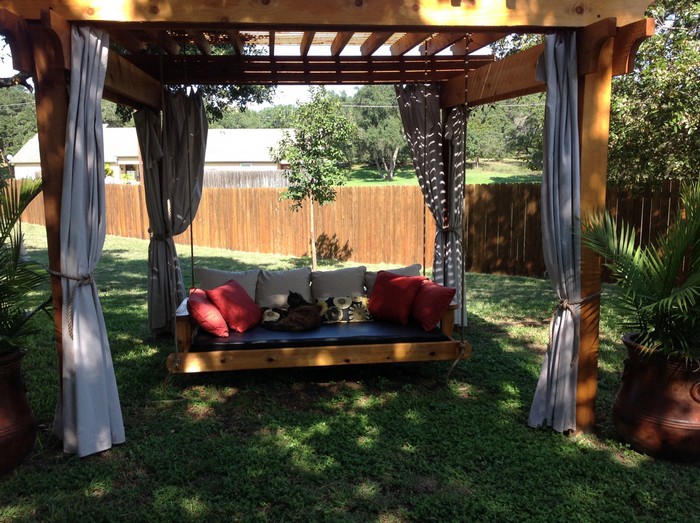
Poolside Deck
For the ultimate resort-style relaxation, consider installing a hanging daybed near your pool. A shaded area by the pool provides a comfortable lounging spot to dry off or take a break from swimming. Opt for water-resistant materials, such as teak wood and quick-dry cushions, to prevent damage from moisture. A poolside daybed can enhance the aesthetic of your outdoor space while offering a luxurious place to unwind.
Balcony or Small Patio
If you have limited space, a compact hanging daybed can transform a small balcony or patio into a private retreat. Choose a single-seat swing-style daybed to maximize the area. Since balconies often have weight limitations, use lightweight materials and consult a professional to ensure safe installation. This setup is perfect for apartment dwellers who want a cozy outdoor escape without needing a large yard.
Wherever you choose to hang your hanging daybed, always prioritize safety. Ensure the structure can support the combined weight of the bed and its users, and use high-quality hardware for secure mounting. With the right placement, your hanging daybed will become a favorite spot for relaxation, offering both comfort and style.
Conclusion
Building a hanging daybed is a rewarding project that adds both comfort and style to your home. Choosing the right materials, securing a sturdy hanging spot, and following proper installation steps ensure a safe and long-lasting setup. With the right care, your swinging daybed will provide years of relaxation, whether on a porch, in a garden, or even indoors.
We have more functional seats for your home. Read our guide on a wood porch swing next!

